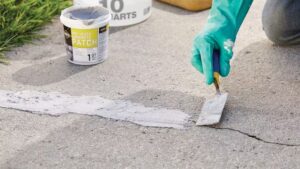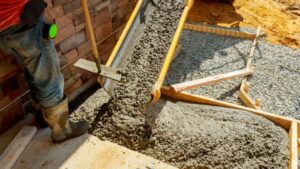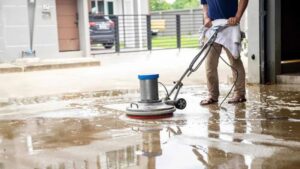When it comes to concrete work, having the right tools can make all the difference in achieving professional-quality results. Whether you’re working on a small DIY project or tackling a large construction task, using the proper tools ensures that your job is done efficiently, safely, and with precision.
From mixing to pouring and finishing, each step in the concrete process requires specialized equipment to handle the tough, durable nature of concrete. In this guide, we will explore the top 11 essential tools you need for concrete work, helping you build a solid foundation for any project.
Top 11 Tools You Need For Concrete Work
1. Concrete Mixer
A concrete mixer is one of the most essential tools for any concrete work, especially for larger projects. Mixing concrete by hand can be time-consuming and inconsistent, leading to poor quality results. A concrete mixer automates the process, ensuring a uniform mix of cement, sand, and water.
This uniformity is crucial because it guarantees the strength and durability of the concrete. Concrete mixers come in different sizes, ranging from small portable mixers for DIY projects to large industrial mixers for bigger construction jobs. By using a mixer, you can save time, reduce labor, and achieve consistent, high-quality results every time.
Also Read:- Budget-Friendly Backyard Concrete Projects
2. Wheelbarrow
A wheelbarrow is indispensable when transporting mixed concrete from the mixing site to the pouring area. It allows you to move heavy loads efficiently, which is critical when working with concrete. Wheelbarrows designed for concrete work are typically built with reinforced materials to handle the weight and abrasiveness of wet concrete.
They come with pneumatic tires for easy maneuverability on rough terrain and stable pouring without tipping over. Using a durable wheelbarrow helps you save time and energy, enabling you to focus more on the quality of your work rather than the logistics of moving materials.
3. Shovels
Shovels are fundamental in concrete work, used for mixing, spreading, and scooping concrete materials. While a typical garden shovel might suffice for small jobs, a square-point shovel is ideal for most concrete tasks. Its flat edge makes it easier to move and spread concrete more evenly than rounded alternatives.
Shovels also come in handy for mixing concrete in wheelbarrows or mixing trays when you’re not using a concrete mixer. Additionally, they are excellent tools for preparing the ground by removing debris and leveling the surface before pouring the concrete.
4. Screed
A screed is a long, straight edge, typically made of aluminum or wood, used to level freshly poured concrete. After you’ve poured the concrete, the screed is dragged across the surface to remove excess material and ensure a level finish.
Screeds come in manual and power variations, with the latter often used for larger commercial jobs. Precision is key when using a screed, as it directly affects the flatness and smoothness of the finished surface. Using the right screed can help avoid low spots or uneven areas in the slab, ensuring a professional-grade finish.
5. Trowels
Trowels are critical for smoothing and finishing concrete surfaces once the screeding process is complete. There are different types of trowels for various finishing needs, including hand trowels and power trowels. Hand trowels, typically made of steel or magnesium, are perfect for small areas and edges where precision is required.
Power trowels, on the other hand, are used for large surface areas, ensuring an even, smooth finish. Trowels help eliminate any remaining surface imperfections and provide the final touch in the finishing process, giving your concrete work a polished, professional appearance.
6. Float
A float is used after screeding but before troweling to smooth and level the surface of the concrete. Floats come in various forms, including hand floats, bull floats, and magnesium floats, each designed for specific tasks.
The purpose of a float is to bring the cream (the fine material) to the surface and push down larger aggregates. This process helps seal the surface, making it easier to finish with a trowel. Floats also help create a uniform texture, whether you’re aiming for a smooth finish or a slightly textured, slip-resistant surface.
7. Edger
Concrete edgers are essential for creating smooth, rounded edges along the sides of a concrete slab. This tool helps to prevent the edges from chipping or cracking over time, improving the durability and aesthetic appeal of the project. Edgers come in different sizes, depending on the radius of the edge you want to create.
They are especially useful for concrete walkways, driveways, or patios, where sharp edges can become problematic. By using an edger, you ensure that the slab looks polished and professional, with smooth, rounded edges that last longer.
8. Concrete Vibrator
A concrete vibrator is a tool used to remove air pockets trapped within the concrete mix after it is poured. Air pockets can weaken the structural integrity of the concrete, causing it to crack or crumble over time. Vibrators come in different types, including internal, external, and surface vibrators.
Internal vibrators are inserted into the wet concrete to ensure that it settles properly and forms a dense, solid structure. Using a concrete vibrator is crucial for large pours, ensuring that the finished product is free of voids and weak spots, which enhances the durability of the concrete.
9. Level
A level is essential for ensuring that your concrete surface is flat and even. Levels come in various sizes, from small hand levels to long spirit levels, depending on the size of the surface you’re working on. After pouring and screeding the concrete, use a level to check for any uneven areas that may need adjustment.
A level is also helpful when setting forms or placing reinforcement bars (rebar) to ensure everything is properly aligned. By using a level throughout the process, you can ensure that the finished concrete surface is structurally sound and aesthetically pleasing.
10. Kneeling Boards
Kneeling boards are designed to protect your knees while working on freshly poured concrete. They allow you to work comfortably on top of the slab without damaging the surface. Kneeling boards distribute your weight evenly, preventing indentations or marks in the wet concrete as you smooth and finish the surface.
These boards are especially useful when troweling or floating large areas where prolonged kneeling is required. By using kneeling boards, you can maintain the quality of your work while avoiding discomfort or injury during the project.
Also Read:- Sustainable Alternatives To Traditional Concrete
11. Concrete Saw
A concrete saw is an essential tool for cutting concrete slabs, blocks, or pavers. It is typically used after the concrete has partially cured but is still soft enough to cut without cracking. This tool helps in creating control joints, which are necessary for preventing cracks from forming as the concrete expands and contracts due to temperature changes.
Concrete saws are available in many styles, such as walk-behind saws for larger work and hand-held ones for smaller tasks. A concrete saw ensures clean, precise cuts, helping to maintain the structural integrity and appearance of your concrete work.
Conclusion
Investing in the right tools for concrete work can greatly improve the quality of your projects while saving time and effort. Each of the tools listed is crucial to ensuring precision, safety, and durability. With the proper equipment in hand, you’re well-prepared to handle any concrete-related task, whether it’s a small home improvement project or a larger construction job.
FAQs
What are the most important tools for concrete work?
The most important tools for concrete work include mixers, trowels, screeds, and finishing tools to ensure smooth, precise surfaces.
Can I do concrete work without professional tools?
While it’s possible, using professional tools will significantly improve the quality and efficiency of your work.




